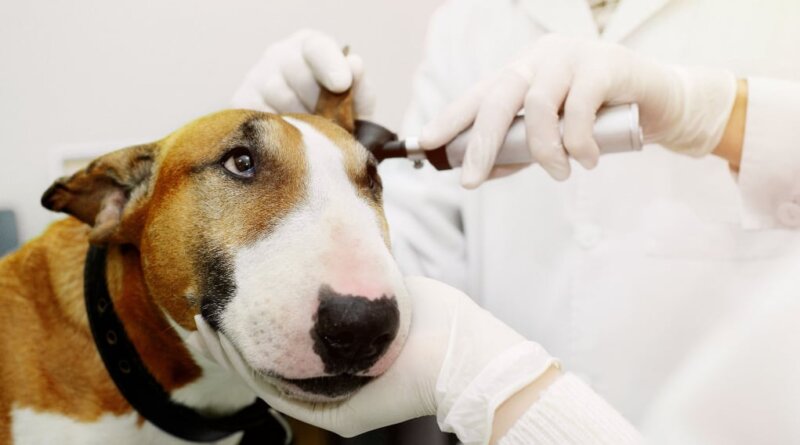7 Easy Tips to Make Your Deaf Dog Live Normally – Top Dog Tips
Did you know?
Dogs have sharper hearing senses than hoomans — ranging between 45Hz to 65KHz.
And when their hearing is impaired, you can just imagine your dog losing a significant part of its life, too.
Unfortunately, deafness in dogs is not a rare phenomenon.
According to the American Kennel Club:
…about 5 to 10 percent of dogs in the United States suffer from deafness, either in one ear (unilateral) or both ears (bilateral).
Commonly occurring in senior canines, are deaf dog hearing aids a thing?
Well, according to Dr. Calum Turner of Wag!, there are methods for hearing aids in dogs, “but they are not very practical.”
So, in this blog, I compiled all the things you need to know about hearing loss in canines, including the following:
- How to get deaf dog hearing aids
- What causes hearing loss in dogs
- 7 meaningful tips to help your Fido live a normal life
- And so much more!
Let’s get right into it, shall we?
What are dog hearing aids?
Dog hearing aids are medical tools used to help your pups cope with hearing loss.
And just like humans, dogs can also use hearing aids to help amplify the sound coming into their ear canal.
However, hearing restoration methods and tools may not work for some dogs.
And especially if your deaf dogs aren’t comfortable with a foreign object on their ear, getting them used to it can take time.
Are deaf dog hearing aids readily available in the market?
Contrary to popular belief, deaf dog hearing aids are actually custom-made by your vets.
However, experts say that this procedure is only often used.
According to Dr. Mike Paul of PetHealth Network, one of the reasons is that:
Hearing aids cost about $3,000 to $5,000 and there are no guarantees.
That being said, deaf dog hearing aids don’t restore your dog’s normal state of perceiving sounds.
And unlike humans, dogs can’t identify distorted or unfamiliar sounds that they hear using such a device.
Plus, the amount of sound that penetrates your dog’s hearing aid is only limited.
“You do not just fit the hearing aids and resume your life as it was before,” Dr. Paul adds.
With that in mind, the rest of your family members need to adapt and help your dog cope with its surrounding using the hearing aid.
Note: Teaching your deaf dog how to interpret what it hears using the device can take time and patience.
How to Get a Deaf Dog Hearing Aid From Your Vet
To support your dog’s hearing loss, the following are the typical steps done by your vet, according to Dr. Mike Paul:
Step 1: Your dog must have a diagnostic and hearing test performed, such as the Brainstem Auditory Evoked Response (BAER).
Step 2: Further evaluation is done to identify your dog’s hearing condition.
Step 3: Should your vet sees the need for a hearing aid, ear molds are then made.
Step 4: The hearing aids are created.
Step 5: The deaf dog hearing aids are fitted and fine-tuned.
What causes deafness in dogs?
1. Genetics
Congenital deafness or hearing loss at birth is reportedly common in more or less 100 canine breeds, according to Louisiana State University.
And especially for dogs with white fur and spotted or patched coat patterns, their risks are higher.
This phenomenon is due to the lack of colored or pigmented cells in their ears.
Trivia: About 30% of Dalmatians are born deaf in either one or both ears.
Meanwhile, congenital deafness is also common with other canine breeds, such as:
2. Old Age
Aging dogs are the most vulnerable to deafness due to some changes in their ear or the nervous system as they age.
That said, hearing loss in senior dogs can strike when they reach the age of 10 years or older.
And while hearing loss in older dogs is considered to be incurable, they don’t really become completely deaf.
Chances are, they can still hear high-pitched sounds.
But unfortunately, gradual hearing loss can make your senior dogs less active than usual.
3. Injuries, Trauma, and Noise Exposure
When it comes to canine hearing loss, genetics and age aren’t the only factors that come into play.
So are injuries, trauma, and loud noise exposure.
While temporary deafness can be curable, the intensity of the ear damage can cause it to be permanently deaf.
Did you know: Hunting dogs are more vulnerable to permanent deafness due to exposure to loud gun blasts.
4. Infections and Diseases
Canine hearing loss is also caused by underlying medical conditions, such as ear infections and diseases.
Ear Infections
Ear mites are parasites that live, grow, and multiply in your dog’s ear that discharges a waxy substance.
This thick wax can block your dog’s ear canal, resulting in infections and temporary or permanent deafness.
Fortunately, ear mites infestation can be treated with the following medications:
To prevent ear mites from infesting your pup’s ears, be sure to clean them regularly.
Tumor and Cancer
Dogs with ear tumors or cancer are also vulnerable to hearing loss, especially if left untreated.
Once the tumors and other cancerous growths in your dogs are surgically removed, the risk of deafness is reduced.
Or can return to normal if your dogs are diagnosed with partial hearing loss.
To properly assess this condition, it’s best to seek your vet’s help for accurate procedures and diagnosis.
Deaf Dog Hearing Aids: Symptoms of Canine Hearing Loss
If you think your Fido has hearing loss, take note of the following symptoms:
- Difficult to awaken
- Disorientation and inattention
- Inability to locate or track sounds
- Startles easily, especially after sleeping
- A decrease in response to voice or clicker commands
Some dogs with deafness may become more vocal and energetic, especially the younger ones.
Can you prevent deafness in dogs?
Deafness in dogs cannot be prevented, given that all dogs will age. Plus, the threats of genetics.
But it’s good to note that not all dogs go deaf when they grow old, too.
It boils down to the quality of life you give your dogs.
And according to Dr. Patrick Mahaney of the Veterinary Cancer Group:
Generally, maintaining the overall health of your dog and the cleanliness of his ear canal is the best way to promote normal hearing.
Deafness in dogs may not be preventable, but you can definitely help support your pup’s health by taking care of its well-being.
RELATED: When It’s OK Not To Clean A Dog’s Ears
Deaf Dog Hearing Aids: 7 Tips to Make Your Deaf Dog Live Normally
1. Train your deaf pup with hand signs
While there are no official hand signs for deaf canines yet, you can try and use the following suggestions from actual deaf dog owners of dfordog.co.uk:
2. Boost your Fido’s sense of smell
According to dog training expert Turid Rugaas, dogs rely more heavily on their sense of smell than their hearing.
And especially when they become deaf, dogs process their environment by smelling.
Interestingly, a study found that olfactory stimulation directly affects a dog’s behavior.
Dogs spent more time resting and less time moving upon exposure to lavender and chamomile.
The same study also claims that dogs that are exposed to lavender and chamomile showed “less vocalization.”
Meanwhile, a rosemary and peppermint-diffused environment impacts dog behavior, too.
The study found dogs to be “significantly more standing, moving and vocalizing” than other aromas.
With this valuable information in mind, you can try to put an oil diffuser at home as a natural deaf dog hearing aid.
This helps stimulate your deaf pup’s behavior and mood.
RELATED: 9 Reasons to Use Essential Oils for Dogs
3. Customize your pup’s collar
It’s important to let the community be aware of some dogs’ medical conditions.
With hearing loss limiting a dog’s capabilities, giving people a heads-up is crucial.
That being said, you can create or buy customizable dog collars for your deaf pup.
Especially in cases of emergencies, you can be easily contacted by engraving your name or phone number on your dog’s collar.
You can also state on the collar that your dog has hearing loss or is currently in a hearing aid.
4. Avoid startling your deaf dog
The truth is, some deaf dogs can be more responsive to their surroundings than normal pups.
Do deaf dogs have heightened senses?
Deaf dogs can be more sensitive to their environment due to their impaired sense of hearing.
This means to say, they rely on their other senses to respond to certain stimuli.
So, if you’re trying to wake your sleeping pooch, be sure to pat its shoulder gently.
Another thing is to avoid approaching or touching your dog when you are not within its field of vision.
This is to prevent accidents or canine aggression at home.
5. Be vigilant and pay attention
When you have deaf dogs at home, it’s important to pet-proof your front or backyard.
Because chances are, your deaf pups can bolt into the street to and fro, making them more prone to accidents.
And before I forget, always put your deaf Fidos on a leash when you use the driveway or garage.
There are cases of deaf dogs getting hit or run over by their owner’s car while pulling in and out of the driveway.
And putting your deaf dogs on a leash also helps control their aggressive behavior (if any) toward neighbors, kids, or joggers in the area.
6. Be more patient and understanding
Unfortunately, sensory deprivation (loss of senses) is a common cause of anxiety in dogs.
And unlike congenital hearing loss, dogs that suffer from acquired or gradual deafness can be confused with their new silent environment.
If this is the case for your pup, shower it with lots of love and time to help them cope with their condition.
Play with them, still, and let them know that your routines wouldn’t change at all.
7. Visit your vet regularly
Deaf dogs may have one sense down, but that doesn’t mean skipping your regular trips to the vet.
Well, dogs with hearing impairment are still normal pups.
And the more they need special attention, the more you need to seek expert advice.
Deaf Dog Hearing Aids: FAQs
Can a deaf dog regain hearing?
Deaf dogs can regain their hearing in cases of acquired or temporary deafness caused by ear infections, ear wax buildup, or ruptured eardrums.
However, deafness from old age cannot be cured and is considered to be permanent.
Can deaf dogs hear anything?
Some deaf dogs can still hear sound frequencies depending on their hearing condition — partial or complete deafness.
The type of whistle, on the other hand, also is a contributing factor.
Shrill or disaster whistles produce strong sounds than regular ones.
Is there a cure for deafness in dogs?
Unfortunately, there’s no surefire cure for deafness in dogs.
But vet experts can treat underlying conditions that cause temporary hearing loss in your dogs, such as ear infections, blocked ear canals, and medication side effects.
At what age do dogs go deaf?
Dogs can become deaf as they age, typically reaching more or less 10 years old.
Some senior dogs, however, don’t go completely deaf.
But unlike temporary deafness, dogs who become deaf with old age cannot be cured.
Can a deaf dog hear a whistle?
Some deaf dogs can hear sound frequencies, especially from a shrill dog whistle.
Storm or disaster whistles also have strong sound frequencies that deaf dogs can still perceive.
However, it’s also good to note that dogs with hearing loss can have different responses to sound, especially if they’re partially or completely deaf.
How do you quiet a deaf dog?
To quiet a deaf dog, you need to assess what causes it to bark. It could be an insect or other animals in the area.
While training your deaf dog can be challenging, you can offer them toys to divert their attention.
In some cases, deaf dogs bark if they want something or feel unwell, too.
So, be sure to pay attention since deaf dogs resort to barking to communicate with you.
Can deaf dogs be left alone?
Deaf dogs shouldn’t be left alone, especially when they lack early training.
When left alone for long periods, deaf dogs can become destructive and aggressive at home.
Not to mention the non-stop, loud barking.
How much do hearing aids in dogs cost?
Hearing aids in dogs cost around $3,000 to $5,000, depending on the procedure or materials used.
While dog hearing aids are a meaningful investment for your pet, some methods may not work for some pups.
So before spending a hefty sum, consult your vet to assess your dog’s hearing condition properly.
Deaf Dog Hearing Aids: Before You Go…
Hearing loss in dogs is truly heartbreaking.
And the more knowing that:
Hearing aids for dogs are expensive and have a generally low success rate. — Dr. Calum Turner
While deaf dog hearing aids can be a purposeful investment, your pup’s reaction is a big question mark.
That’s because some deaf Fidos are not used to foreign objects in their ear.
Plus, deaf dog hearing aids also limit the amount of sound your furballs can hear.
And just like human hearing aids, there can also be distorted sounds that the device captures.
While hoomans can perceive sounds better, it may not work the same for canines.
But know that this isn’t the end of the road for you and your pup.
Of course, you can try training your furry bundle of joy using hand signs.
Or try putting an oil diffuser with aromas that can help stimulate your pup’s other senses and boost their mood.
And most importantly, don’t forget the affection, time, and understanding, too.
If this blog helped you in any way, you might as well take bits of valuable information from the following recommendations!
RELATED ARTICLES:








